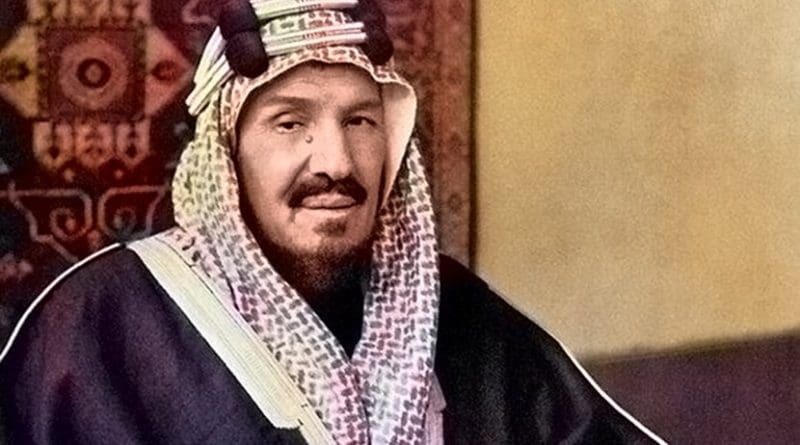The Vision Of Saudi Arabia’s Founder – OpEd
By Arab News
By Faisal Mrza*
With the launch of Saudi Vision 2030 in April 2016, the Kingdom is at a crossroads. While crude oil has been the nation’s past, its future depends on us improvising with talents and techniques to make much more of the resources we have been given.
Decades ago, the vision of Saudi Arabia’s founder, King Abdul Aziz, made the Kingdom the largest oil exporter and placed it among the world’s strongest G-20 economies. Now, Saudi Vision 2030 is being orchestrated by the founder’s wise grandson. It is our vision that we must believe in to prosper and thrive.
As Saudi Arabia marks National Day, it is a good time to remember what has underpinned the economy for decades. March 2018 marked the 80th anniversary of the first discovery of oil in commercial quantities in Saudi Arabia. This discovery took place in March 1938 at the site known as Dammam Well No. 7, “the Prosperity Well.”
Oil exploration by Standard Oil Company of California (SoCal) under its wholly owned subsidiary California-Arabian Standard Oil Company (CASOC) started in the Kingdom in September 1933 after the issuance of royal decree number 1135 “granting a concession for the exploitation of petroleum.” After five years of hard, often frustrating work, geologists and drillers found oil in commercial quantities near Dhahran at the Dammam Dome at 1441 meters. This was good quality crude. On May 1, 1939, King Abdul Aziz turned the valve of the newly completed 69-kilometer pipeline from Dammam oil field to Ras Tanura Port, and the first oil shipment was on its way.
When discussing the famous Dammam Well No. 7, it is essential to mention Max Steineke, chief geologist at CASOC, which later became Saudi Aramco. Steineke is entitled to credit for discovering the large oil reserves which have been found in Saudi Arabia. This was of course based on instructions from King Abdul Aziz, who had searched for oil from the early 1920s.
Perhaps the greatest moment of Steineke’s professional career was on March 3, 1938, when Dammam Well No. 7 began producing at 1,585 barrels per day. Then, on March 22, the well increased output to 3,810 barrels per day. Saudi Arabia’s financial future was written in black gold.
Before the discovery of oil, Saudi Arabia’s economy depended mostly on the income it earned from hosting the Hajj. Once King Abdul Aziz united Saudi Arabia, there was an opportunity to begin developing other resources. In 1922, King Abdul Aziz first became interested in searching for oil after meeting Frank Holmes, a New Zealand mining engineer. Initially, looking for oil in Saudi Arabia was considered risky. Even though Holmes had a concession to search for oil, there were no willing investors. It was not until 1932, when oil was struck in Bahrain, that enthusiasm increased for a Saudi find.
King Abdul Aziz had not been sitting idly by over that decade. When Holmes did not succeed in finding oil, King Abdul Aziz consulted others, including American businessman Charles Crane and American mining engineer Karl Twitchell. He was determined to reach his goal.
Even once CASOC began managing the concession, there was no immediate success. Steineke joined the team of geologists in 1934 and by 1936 had become the company’s chief geologist. He initiated geological surveys that included structural drilling to find likely oil fields. Unfortunately, failure was the repeated outcome of his work. Six expensively drilled test wells in Dammam were unsuccessful in finding commercial quantities of oil. Drilling on well No. 7 was underway when Steineke was told that exploration in Saudi Arabia would cease. Dammam Well No. 7 had experienced numerous problems and drilling was proceeding slowly. As so much expense had already been incurred, and on the urging of King Abdul Aziz, Steineke convinced SoCal to let the deep test well drill continue. Their belief in Saudi oil paid off.
Saudi Aramco and Saudi Arabia will never forget Steineke’s brilliant use of his talents for the benefit of the Kingdom. Wielding basic tools, and improvising tactics and techniques under difficult conditions, Steineke and the geologists on his team discovered the oil fields of Dammam, Abu Hadriyah, Abqaiq and Ghawar — the largest oil field in the world. King Abdul Aziz lived to see the discovery of all of these fields and knew that the prosperity of Saudi Arabia was assured.
As the founder of this great nation, King Abdul Aziz had the vision to look far ahead for the welfare of Saudi Arabia. In his years of searching for oil King Abdul Aziz never gave up, and the nation has reaped the fruits of his momentous success.
We have been dependent on oil income for 80 years. The time has come for a change. Saudi Vision 2030 is an effort to use the wealth earned from our oil-based economy to diversify our income sources, and move the Kingdom forward to a future of sustainable prosperity.
*Faisal Mrza is an energy and oil marketing adviser. He was formerly with the OPEC and Saudi Aramco. Twitter:@faisalmrza

